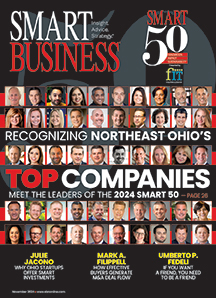When Rudy’s Hardware closed its doors this past spring after 54 years in Slavic Village, dozens of area business volunteers packed up the store’s inventory and donated it to Greater Cleveland Habitat for Humanity with the hope the items can help rebuild local communities. Little did owner Rudy Rosales know how quickly his dream would come true.
Some of the tools and gadgets have already been used in a rehabilitation project in the same Southeast Cleveland community. The rest are part of a new hardware section of Greater Cleveland Habitat for Humanity ReStore on West 110th Street.
John Habat, executive director of the Greater Cleveland Habitat for Humanity, couldn’t be more excited about the donation.
“He gave us the whole hardware store,” he says. “We will dedicate our hardware section, call it ‘Rudy’s Hardware.’ People are really looking forward to it because they know we have these old parts. It’s just amazing.”
The business model changes
Building partnerships with the community and area corporations is what has enabled Habitat for Humanity to build more than 180 homes and help more than 1,000 parents and children since its inception in 1988. Like the rest of the country, however, the demand for new homes in Cleveland started to dwindle, creating the need for a new business plan.
“We’ve changed dramatically,” Habat says. “The way Habitat started, not only in Cleveland, but everywhere, was to build a new, simple, affordable home for a family that otherwise would not have the ability to own their own home.”
While that business model works for most Habitat for Humanity groups across the U.S., Cleveland found itself in a unique situation.
“Being the epicenter of the foreclosure crisis and the double whammy of the great recession, there was street after street after street with multiple vacancies due to abandoned homes,” Habat says. “For one reason or another, families abandoned homes.”
That wasn’t the only challenge facing the nonprofit. A common Habitat for Humanity home is an 800-square-foot ranch that sits on a slab and comes without a basement or garage, but now, the organization had to comply with the city’s housing standards.
City officials wanted new houses to be aesthetically consistent with the architecture of the neighborhood. Officials wanted the new homes to be three-floor style homes, which in a good economy appraise for up to $200,000, far exceeding the typical $65,000 value of a Habitat for Humanity home. It was time for a change.
“We confronted that reality, and we confronted the reality of massive vacancies and houses abandoned and left to deteriorate amid neighborhoods where there were families still trying to make that neighborhood survive,” Habat says. “We moved exclusively last year to rehabbing vacant and abandoned houses in the city of Cleveland.”
The goal was to make a difference in a neighborhood, and that was best done by fixing up five or 10 homes and helping those homeowners with critical exterior repairs, landscaping improvements and debris removal.
“So Habitat became more than a homebuilder, it became a neighborhood builder,” Habat says. “I think that is what is of interest to foundations, whether they’re corporate or private foundations. They want more of an impact than on one house or one family — they want to impact a community.”
Building business relationships
Since Greater Cleveland Habitat for Humanity adopted this model, it has attracted more interest from the local business community.
“I think the more well-known our model becomes, the more interested they will be in it because it really does have a significant impact on the city of Cleveland,” Habat says. “It helps families, it helps children, it helps the tax base and it helps neighborhoods — and the neighborhoods are the fabric of a city.”
Besides enlisting the help of corporate employee volunteers from local businesses, Greater Cleveland Habitat for Humanity has other ties with community partners. For example, each year area corporations provide donations to the group’s affordable housing program as well as the ReStore.
Looking to the future
For the remainder of the year, Greater Cleveland Habitat for Humanity is working with Slavic Village, Fairfax and the lower Kinsman neighborhood. Next year, the group will select another two or three communities that are in dire need and work with their neighborhood development corporations to get the work completed. Nonetheless, there are still challenges that face the organization, including the need for affordable housing.
“While the need is overwhelming, we bring together over 1,200 volunteers a year who contribute to helping this large segment of the population,” Habat says. “They take these stories home to the suburbs and create awareness of the need and of the ability of anyone to make a difference. We can serve more families if the financial support is there.”
How to reach: Greater Cleveland Habitat for Humanity, (216) 429-1299 or www.clevelandhabitat.org
To learn more about Greater Cleveland Habitat for Humanity, like its Facebook page www.facebook.com/HabitatforHumanityGreaterCleveland and follow on Twitter @GCHFHReStore.

